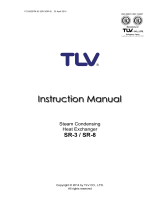
13 | GS Series Installation
General Requirements
The vent systems shall be listed to UL or UL/CSA standard and meet the installation requirements of the
national fuel code in the USA (ANSI z223.1) and the Canadian standards CSA B149.1 installation codes.
Any local jurisdictions reflecting changes to the above codes should be observed.
In applying the codes, reference should be given to the venting manufactures instructions, the serving
gas supplier regulations, and the specific instructions provided in this manual.
This appliance must be installed to comply with national regulations and codes. A qualified technician,
competent with these codes and the local requirements of the jurisdiction must carry out the installation.
Proper removal of combustion gases must be assured, and building materials must be protected from
degradation by flue gases.
Never mix venting types (B to BH or vice versa.) Never use two different manufacturer’s equipment for
the same chimney.
All vent runs should be as direct as possible with no more than 6 elbows in the system. Maintain an
upward slope of ¼” per ft on all horizontal vent pipe runs.
This appliance shall not be connected to a chimney flue servicing a separate appliance designed to burn
solid fuel.
This appliance may not be used in conjunction with a power venter or draft inducer.
For any vent lengths over 20 feet long, insulate the vent pipe to reduce the amount of condensate that
could form in the flue gases.
When the venting passes through a cold area or location that has large amounts of air passing over the
venting, it should be insulated to prevent condensation from forming inside the venting.
Vent pipe passing through walls, floors, and ceilings, must be installed with the proper clearances from
combustible materials, and venting manufactures fire stop equipment.
The venting shall not pass through any circulation air duct or plenum.
A drip “T” should be used for condensate removal. When a condensate drain is used it will be necessary
to install a trap to prevent flue gases from escaping. Install a trap with a minimum 12” standing water
column.
Prior to activating the appliance, ensure that the trap is filled with water and that the drain terminates in
accordance with local plumbing codes.
Never vent into an unlined masonry or concrete chimney unless the chimney is sized and installed
according to the provisions of the national fuel code in the USA (ANSI z223.1) or the Canadian standards
CSA B149.
Chimney or vent should extend at least 3’ (1 m) above a roof and at least 2’ (.6 m) above any ridge within
10’ (3 m) of the chimney. Local codes apply.
Install venting so as to prevent accumulation of condensate and have a means for condensate removal.
Plastic, PVC, CPVC and HTPV special gas vents are not approved for use with this appliance.
Select vent material and clearance according to the max vent gas temperature.
All horizontal runs must be adequately supported with hangers or straps to prevent sagging.
The vent must terminate at a sufficient height above the roof to prevent blockage by expected snowfall.























